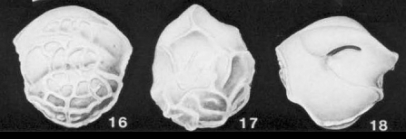Foraminifera taxon details
Burseolina calabra Seguenza, 1880 †
761027 (urn:lsid:marinespecies.org:taxname:761027)
accepted
Species
Cassidulina calabra (Seguenza, 1880) † · unaccepted (Type species of Burseolina)
marine, brackish, fresh, terrestrial
fossil only
Seguenza, G. (1880). Le formazioni terziarie nella provincia di Reggio (Calabria). <em>Memorie della Classe di Scienze Fisiche Matematiche e Naturali della Regia Accademia del Lincei.</em> 3(6):1–445, pl. 1-17., available online at http://www.biodiversitylibrary.org/item/89318
page(s): p. 138, pl. 13, figs. 7a, b; note: For the extant species from the Pacific, see Burseolina pacifica (Cushman, 1925). [details]
page(s): p. 138, pl. 13, figs. 7a, b; note: For the extant species from the Pacific, see Burseolina pacifica (Cushman, 1925). [details]
Taxonomic remark For the extant species from the Pacific, see Burseolina pacifica (Cushman, 1925).
Cushman (1925, p. 55): "Burseolina...
Cushman (1925, p. 55): "Burseolina...
Taxonomic remark For the extant species from the Pacific, see Burseolina pacifica (Cushman, 1925).
Cushman (1925, p. 55): "Burseolina calabra Seguenza, Atti R. Accad. Lincei, ser. 3, vol. 6, 1880, p. 138, pl. 13, figs. 7a, b. Types from Reggio, Calabria, Italy. The original figures given by Seguenza does not at all resemble a Cassidulina, Brady had type material sent him for examination, and placed them under Cassidulina although Seguenza places his genus Burseolina between Pullenio. and Nonionina, and his figures certainly resemble these. Brady refers material from the South Pacific to this species of Seguenza, and figures what is certainly a Cassidulina from this region. There are numerous other records based on Brady's figure in the Challen- ger Report, and these are all from the Pacific or Antarctic. It would seem, therefore, that the Pacific species is different from that of Seguenza, and might deserve a new name, which we will propose as Cassidulina pacifica Cushman, new name. (Pl. 9, figs. 14-16.) Brady's Challenger specimen figured, which has a different shape and certainly a very different aperture from that figured and described by Seguenza, may be taken as the type." [details]
Cushman (1925, p. 55): "Burseolina calabra Seguenza, Atti R. Accad. Lincei, ser. 3, vol. 6, 1880, p. 138, pl. 13, figs. 7a, b. Types from Reggio, Calabria, Italy. The original figures given by Seguenza does not at all resemble a Cassidulina, Brady had type material sent him for examination, and placed them under Cassidulina although Seguenza places his genus Burseolina between Pullenio. and Nonionina, and his figures certainly resemble these. Brady refers material from the South Pacific to this species of Seguenza, and figures what is certainly a Cassidulina from this region. There are numerous other records based on Brady's figure in the Challen- ger Report, and these are all from the Pacific or Antarctic. It would seem, therefore, that the Pacific species is different from that of Seguenza, and might deserve a new name, which we will propose as Cassidulina pacifica Cushman, new name. (Pl. 9, figs. 14-16.) Brady's Challenger specimen figured, which has a different shape and certainly a very different aperture from that figured and described by Seguenza, may be taken as the type." [details]
Hayward, B.W.; Le Coze, F.; Vachard, D.; Gross, O. (2024). World Foraminifera Database. Burseolina calabra Seguenza, 1880 †. Accessed at: https://www.marinespecies.org/foraminifera/aphia.php?p=taxdetails&id=761027 on 2024-09-25
Date
action
by
original description
Seguenza, G. (1880). Le formazioni terziarie nella provincia di Reggio (Calabria). <em>Memorie della Classe di Scienze Fisiche Matematiche e Naturali della Regia Accademia del Lincei.</em> 3(6):1–445, pl. 1-17., available online at http://www.biodiversitylibrary.org/item/89318
page(s): p. 138, pl. 13, figs. 7a, b; note: For the extant species from the Pacific, see Burseolina pacifica (Cushman, 1925). [details]
additional source Bellini, E. (1956). Rapporti tra <i>Ehrenbergina Dinapolii</i> Gianotti e <i>Burseolina calabra</i> Seguenza. <em>Atti della Società dei Naturalisti e Matematici di Modena.</em> 85-86(1954-1955): 13-19., available online at https://www.socnatmatmo.unimore.it/download/Atti1954-1955.pdf [details] Available for editors [request]
[request]
page(s): p. 138, pl. 13, figs. 7a, b; note: For the extant species from the Pacific, see Burseolina pacifica (Cushman, 1925). [details]
additional source Bellini, E. (1956). Rapporti tra <i>Ehrenbergina Dinapolii</i> Gianotti e <i>Burseolina calabra</i> Seguenza. <em>Atti della Società dei Naturalisti e Matematici di Modena.</em> 85-86(1954-1955): 13-19., available online at https://www.socnatmatmo.unimore.it/download/Atti1954-1955.pdf [details] Available for editors
 Present
Present  Inaccurate
Inaccurate  Introduced: alien
Introduced: alien  Containing type locality
Containing type locality
From editor or global species database
Taxonomic remark For the extant species from the Pacific, see Burseolina pacifica (Cushman, 1925). Cushman (1925, p. 55): "Burseolina calabra Seguenza, Atti R. Accad. Lincei, ser. 3, vol. 6, 1880, p. 138, pl. 13, figs. 7a, b. Types from Reggio, Calabria, Italy. The original figures given by Seguenza does not at all resemble a Cassidulina, Brady had type material sent him for examination, and placed them under Cassidulina although Seguenza places his genus Burseolina between Pullenio. and Nonionina, and his figures certainly resemble these. Brady refers material from the South Pacific to this species of Seguenza, and figures what is certainly a Cassidulina from this region. There are numerous other records based on Brady's figure in the Challen- ger Report, and these are all from the Pacific or Antarctic. It would seem, therefore, that the Pacific species is different from that of Seguenza, and might deserve a new name, which we will propose as Cassidulina pacifica Cushman, new name. (Pl. 9, figs. 14-16.) Brady's Challenger specimen figured, which has a different shape and certainly a very different aperture from that figured and described by Seguenza, may be taken as the type." [details]

